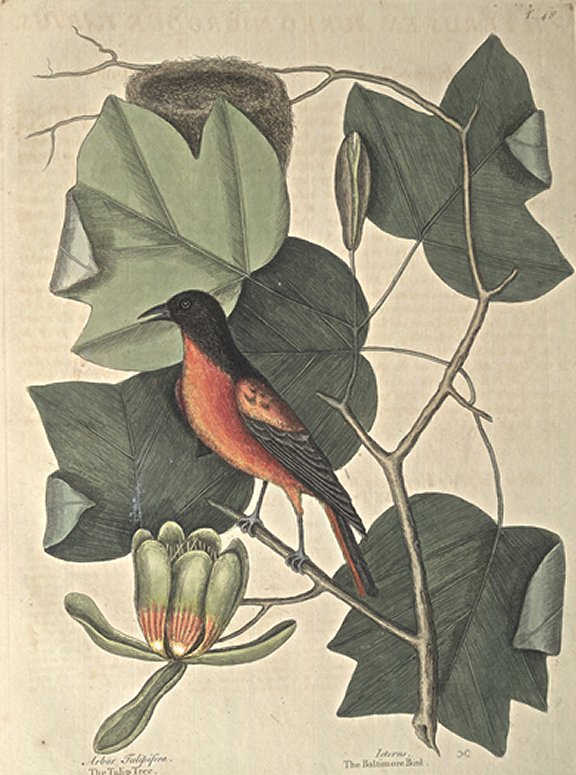Plate Number: I 48Icterus Ex Aureo Nigroque varius: The Baltimore-Bird Is about the Size of a Sparrow; Weighing a little above an Ounce. The Bill is sharp and tapering; the Head and half way down the Back of a shining Black. The Wings, except the Upper-Parts (which are yellow) are black, with most of the Feathers edged on both Sides with White. The rest of the Body is of a bright Colour, between Red and Yellow. The two uppermost Feathers of the Tail are Black; the Rest Yellow: The Legs and Feet of a Lead-Colour. It disappears in Winter. This Gold-colour'd Bird I have only seen in Virginia and Maryland; there being none of them in Carolina. It is said to have its Name from the Lord Baltimore's Coat of Arms, which are Paly of six Topaz and Diamond, a Bend, counterchang'd ; his Lordship being a Proprietor in those Countries. It breeds on the Branches of tall Trees, and usually on the Poplar or Tulip Tree. Its Nest is built in a particular Manner, supported only by two Twigs fix'd to the Verge of the Nest, and hanging most commonly at the Extremity of a Bough. Arbor Tulipsera Virginiana tripartito aceris folio, media lacinia velut abscissaThis Tree grows to a very large Size; some of them being Thirty Foot in Circumference. Its Boughs are very unequal and irregular, not streight, but making several Bends or Elbows; which peculiarly makes this Tree distinguishable at a great Distance, from all other Trees, even when it has lost its Leaves. The Leaves stand on Foot-stalks, about a Finger in Length: They somewhat resemble the smaller Maple in Shape, but are usually five or six Inches over, and instead of being pointed at the End, seem to be cut off with a Notch. The Flowers have been always compared to Tulips: whence the Tree has received its Name; tho', I think, in shape they resemble more the Fritillaria. They are composed of seven or eight Petala; the Upper-part being of a pale-green, and the Lower-part shaded with red and a little yellow intermix'd. They are at first enclosed by a Perianthium, which opens and falls back when the Flower blows. These Trees are found in most parts of the Northern Continent of America, from the Cape of Florida to New-England. The Timber is of great Use. |